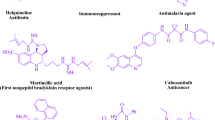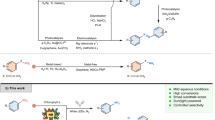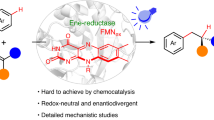Abstract
THE recent communication by Prof. A. Albert1 on the photo-reduction of pteridines prompts me to record another example. In the preparation of 2-amino-4-hydroxy-pteridine-6-aldehyde by the method of Waller et al. 2 it was found that if the initial decomposition of pteroyl-L-glutamic acid to dihydro-2-amino-4-hydroxy-pteridine-6-aldehyde was done in the dark only a poor yield was obtained (as judged by the amount of 2-amino-4-hydroxy-pteridine-6-aldehyde formed on subsequent oxidation). If the reacting solution was irradiated with light from a 100-W. bulb then a good yield was obtained. It thus seems that the decomposition of pteroyl-L-glutamic acid to the dihydro aldehyde is a light-catalysed intramolecular hydrogen transfer from the 9 : 10 position followed by hydrolysis of the resulting anil. It has been previously reported that pteroyl-L-glutamic acid is decomposed by ultra-violet light to 2-amino-4-hydroxy-pteridine-6-aldehyde3. The position of the hydrogen atoms of the dihydro 2-amino-4-hydroxy-pteridine-6-aldehyde in the pyrazine ring has not been established; but this aldehyde would seem to be a possible intermediate in the biological synthesis of the yellow fluorescent eye pigment4 of Drosophila and possibly also of the red pteridine pigments4. Tho primary step in the degradation of pteroyl-L-glutamic acid would seem to be hydrogen transfer intramolecularly to the pyrazine ring or intermolecularly to a suitable hydrogen acceptor (for example, oxygen5 or methylene blue6).
This is a preview of subscription content, access via your institution
Access options
Subscribe to this journal
Receive 51 print issues and online access
$199.00 per year
only $3.90 per issue
Buy this article
- Purchase on Springer Link
- Instant access to full article PDF
Prices may be subject to local taxes which are calculated during checkout
Similar content being viewed by others
References
Albert, A., Nature, 178, 1072 (1956).
Waller, C. W., Goldman, A. A., Angier, R. B., Boothe, J. H., Hutchings, B. L., Mowat, J. H., and Semb, J., J. Amer. chem. Soc., 72, 4630 (1950).
Lowry, O., Bessel, O., and Crawford, E., J. Biol. Chem., 180, 389 (1949).
Forrest, H. S., and Mitchell, H. K., J. Amer. Chem. Soc., 76, 5656 (1954).
Mowat, J. H., Boothe, J. H., Hutchings, B. L., Stokstad, E. L. R., Waller, C. W., Angier, R. B., Semb, J., Cosulich, D. B., and Subbarow, J., J. Amer. Chem. Soc., 70, 14 (1948).
Blair, J. A., Biochem. J., 65, 209 (19576).
Author information
Authors and Affiliations
Rights and permissions
About this article
Cite this article
BLAIR, J. Photo-reduction of Pteridines. Nature 179, 489–490 (1957). https://doi.org/10.1038/179489a0
Issue Date:
DOI: https://doi.org/10.1038/179489a0
Comments
By submitting a comment you agree to abide by our Terms and Community Guidelines. If you find something abusive or that does not comply with our terms or guidelines please flag it as inappropriate.



